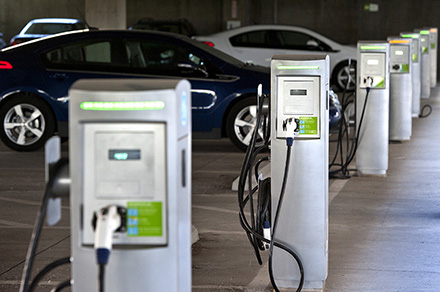|
In 2016, more than 750,000 plug-in electric vehicles were sold around the world: 41% in China, 28% in Europe, and 21% in USA. Pushed by frequent or permanent high pollution levels in many big cities (like Beijing, Paris and London), climate change, and concerns with energy dependency and efficiency, citizens and governments have increased awareness for a more sustainable mobility.
Clear signs in this direction are shown by the Paris agreement at 2015 United Nations Climate Change Conference (COP 21), the growing number of electric propulsion models coming to the market every month, models soon to be available by almost all vehicle manufacturers, and increasing autonomies at affordable prices. Furthermore, some cities and countries are announcing restrictions to the circulation or acquisition of internal combustion engine vehicles.

Besides the usual EV range, battery lifetime, security and cost concerns, two important challenges should nevertheless be pointed out: electric buses and consumers/ vendors education for electric vehicles usage.
Air pollution has spurred an urgent need for electric buses in cities (or plug-in hybrid electric buses). This need foretells a huge market preparing to rocket, with several bus manufacturers presenting new models.
Some very interesting reports about current experiences and models on the road have been presented recently, like the Real World Performance of Hybrid and Electric Buses (Grütter Consulting AG, Feb. 2015), the Electric Bus Analysis for New York City Transit (Judah Aber, May 2016), or the ZeEUS eBus Report, An overview of electric buses in Europe (Dec. 2016).
Some manufacturers are setting up new factories for producing electric buses, as BYD in Hungary, France, Brazil and Argentina. Electric buses will enter the city fleets in great numbers over the next few years.
To increase the range, one possibility is to have very high power charge (1C, 2C or higher), during small stops (some seconds to 10 min) either using cable, wireless or a charging rail like the OppCharge system or similar.
Nevertheless there are still many important questions, like if it would be better (in terms of battery life cycle; energy efficiency; total cost of ownership; etc.) to do slow charging during night and drive the bus to a high Depth of Discharge DoD (90% for example); or to a lower DoD (40%? 60%?) using some fast “opportunistic charges” (OC) of 5 or 10 min with 1C-2C.
This question has many variants: Better to use smaller batteries with OC or bigger and heavier ones with no fast charge during the day? What is the influence of this on bus performance, cost, lifetime? What is the influence of the particular chemistry used in the results (LFP, LTO, NMC, etc.)? These are some of the questions that have to be deeply studied and clarified.
The second challenge is the education of users and vendors. Besides the “traditional” Tesla, other manufacturers are presenting much less expensive vehicles with more than 400 km range, according to the New European Driving Cycle, NEDC, like Renault Zoe (400 km) and Opel Ampera-e/Chevrolet Bolt (520 km NEDC/ 238 Miles EPA).
Firstly, people need to know that this NEDC does not represent the driving profile of most people, and so the real autonomies will be smaller. Indeed, those manufacturers provide simulators for the user to forecast the model’s range according to their driving profile, temperature and other parameters.
But what people need mostly to understand is that choosing an electric vehicle should not be the same as choosing a regular diesel or gasoline car. They do not need to have the same range. Increasing range on a fuel-powered vehicle (for the same weight, vehicle size and shape) means adding some volume to the inexpensive and light gas tank. But for an EV, more range means batteries with more capacity but that are heavier (dozens or hundreds of kg), more expensive (thousands of € or $US), and take more space, which for most of the users will be fully used only in very few occasions.
It is important to analyze carefully the real needs of the user, so they may make a informed decision. Does the family have more than one vehicle? Will most trips be done in city or commuting? Are trips longer than 100 km will be rare, and/or is there a fast charging infrastructure widely available?
If yes, then a comfortable car, with a moderate 25 kWh battery capacity that is therefore more affordable than a 50 kWh car, might be a clever solution (and may allow for a second car of similar capacity). This possibility may be “Why Honda says 80 miles range is enough for its 2017 Clarity Electric” (HybridCARS, April 2017).
And if cars are built using modular battery packs (including the thermal management system), a single model could be sold with different battery packs. For example, it could be sold cheaper and lighter with a 25 kWh battery pack with the possibility of, in a fast and inexpensive operation, add a second 25 kWh (or higher capacity) pack, bought permanently or rented for the holidays or other limited time period. But in other cases, it may be more desirable to use a plug-in hybrid electric vehicle. Or an HEV. |